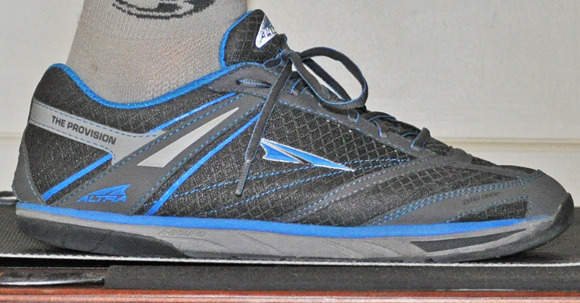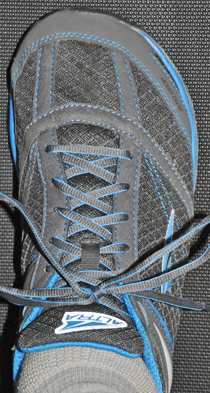August 27, 2012. Mine are. Now that I’m wearing these strange new shoes on my early morning run. The shoes feel great. I feel great. My running feels easier. More comfortable. Perfectly balanced.
My feet weren’t unhappy before I tried these Altra Provision running shoes. Full disclosure: I gave these a try only because an acquaintance at Altra’s parent company – a former client of mine – asked me to do it. I was skeptical and reluctant. I’d been running in a traditional New Balance shoe for 36 years. Without serious injury. I really didn’t want to fix something that wasn’t broken.
But the sales pitch was good. Made sense. But was it true? There was only one Way to find out.
High heels. Not.
These new shoes don’t have an elevated heel. They have a cushioned bottom, but your heels are no higher than your toes. They call it “zero drop” to distinguish it from a traditional shoe bottom that elevates your heel twice as much as your toes. Where the heel-to-toe “drop” is 2-to-1.
The design concept of the Altra shoe: when your heel’s got an elevated platform under it, your heel’s the first thing to hit the ground with every step. That’s called “heel-striking”. A lot of people who know about this think it’s bad. Because it’s unnatural and it transfers the impact from your feet through your legs to your spine in a damaging way. They point out that if you run barefoot, the way we humans did before we invented high heels, you land on your forefoot – not your heel. A whole different posture that our bodies are designed and evolved for.
This sounded logical and appealing. But then I had a flashback to the 1960s. Earth Shoes. They sounded good, too. Their manufacturer pointed out that when you walk barefoot on the beach, your heels sink into the sand. So they designed their shoes with a low heel – and raised toes. Enforced heel-striking. I was one of the fools who bought a pair and walked around on my heels for a few days before trying to get my money back. I did not evolve from ancient beachcombers.
Pointy toes. Not.
The Altra Provision shoes have another unusual feature: a spacious forefoot area or “toe box” that gives you room for your toes to spread out comfortably. Turns out this is a big deal. You notice immediately how comfortable this is. As soon as you start moving, you realize how important this is for balance and stability. You think, yeah, this why we humans have toes. Ten little stabilizers feeling the ground and making thousands of tiny adjustments in real time. To keep you on your feet and off your butt.
Then you have the “ah ha” moment. When you completely understand why these shoes feel so good: they’re the extreme opposite of those super high stiletto-heeled, pointy-toed shoes some hyper-fashionable women stumble around in. No wonder they have trouble stepping off the curb to cross the street. They’re walking on their tiny heels and their toes are numb.
Happy
No wonder I’m having unusually comfortable runs. My feet feel supported and stabilized – without a ton of shoe materials surrounding them. They’re supporting and stabilizing themselves – and the rest of me. They’re happy. So am I.
Making the transition
If you try a pair of these, I hope they’re as good for you as they are for me. To maximize the chance for happiness, you should begin to use them gradually. If you’re a runner: walk, don’t’ run in them, for a week or so. Get used to the feel. It’s different. Then do a few “mini runs”. Five minutes. A week later, step it up to ten minutes if everything feels good.
Whether you’re a runner or a walker, you’ll quickly notice that the lower heel means your calves and Achilles tendons stretch and work more than they did when higher heels “compressed” them. So be sure to do some simple stretching and strengthening exercises to prevent soreness or injury. Calf-rocking. Calf stretches. Heel lifts. Five minutes a day.
The flip side of harder-working calves: more relaxed quadriceps and hamstrings. For the last few years, I’ve had occasional hamstring tightness and soreness. Nothing I’d call an “injury”. But enough that I have to stop running for a few days to get rid of it. I thought it was just a sign of getting older. Something in the old “aches and pains” category. Since I started my zero-drop running, that hamstring tightness has disappeared.
I’m really not into telling you or anybody else what to wear. On your feet or any other body part. It’s a little too personal. But I’ve had such a good experience with these Altra running shoes I thought I should let you know. Because I know you exercise more when it feels good.
The Final Test. And a warning.
After a couple of months running in the Altras, I went back to my trusty old New Balance shoes for one run. Just to see if I would quickly and easily re-adapt. I didn’t. They felt not-natural in a way the Altras never did. I felt myself working to stabilize and balance myself. Like I was wearing high heels.
I’m now feeling a very slight version of this instability even when I’m out on the street in regular walking shoes. Beware: this zero-drop, wide toe box thing could become addictive. You know. One pair leads to another. To another …
A Brief History of Foot Happiness
For about 10,000 years, we humans ran without Nikes and other shoes engineered to cushion and correct foot movement. Evolutionary biologists tell us that, before the invention of spears, the ability to outrun game animals – and enemies – for long distances allowed us to catch our dinner and to survive.
Surviving runners are happy runners. And they live to pass on their genes. And so, we’re told, we humans have evolved as barefoot runners. Runners who land on the forefoot or midfoot. Not the heel.
Fast forward to the invention of the running shoe with the heavily padded and elevated heel. A shoe that causes you to land on your heel. Which brings us to modern times and the big question: Does the higher-heel shoe cause injuries?
The answer: maybe. Maybe not. Some runners suffer repetitive injuries. Some don’t. But there’s a fair amount of emerging evidence that says running in heavily built-up shoes is associated with higher rates of injury.
I care about this because I want to continue running, injury-free, for as long as I can. And I want you to continue – or to start – running or walking briskly. Which you can’t do if you’re injured or even just sore. So here’s some information that might interest you.
From an article in the journal, Nature: “Kinematic and kinetic analyses show that even on hard surfaces, barefoot runners who fore-foot strike generate smaller collision forces than shod rear-foot strikers … Fore-foot- and mid-foot-strike gaits were probably more common when humans ran barefoot or in minimal shoes, and may protect the feet and lower limbs from some of the impact-related injuries now experienced by a high percentage of runners.”
From an article in the journal, Medicine & Science in Sports & Exercise: “Competitive cross-country runners on a college team incur high injury rates, but runners who habitually rearfoot strike have significantly higher rates of repetitive stress injury than those who mostly forefoot strike.”

